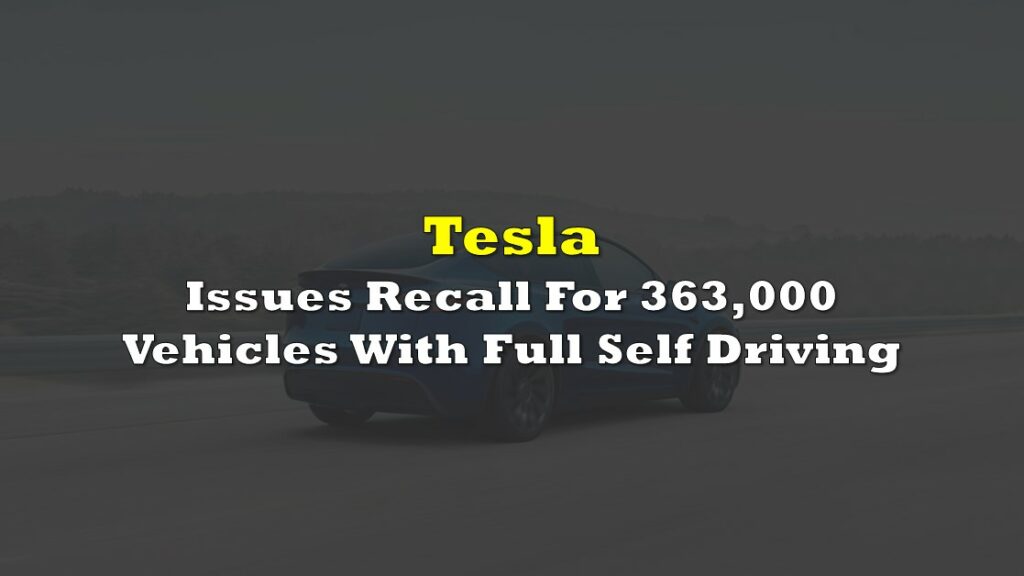Tesla (Nasdaq: TSLA) stock fell more than 7% in the extended session Wednesday after the electric-vehicle manufacturer narrowly missed quarterly revenue projections and saw adjusted profit margins fall as it reduced EV prices.

The revenue for Q1 2023 came in at $23.33 billion, down from Q4 2022’s $24.32 billion but up from Q1 2022’s $18.76 billion. This nearly beat the street estimate of $23.21 billion.
More importantly, gross margin came down to 19.3% from 23.8% and 29.1% in the previous quarter and previous year, respectively. Operating margin also fell to 11.4% from last quarter’s 16.0% and last year’s 19.2%.
The EV maker reasoned that given the potential lifetime value of a Tesla vehicle via autonomy, supercharging, connectivity, and service, its near-term pricing plan takes a long-term view on per vehicle profitability.
“We expect that our product pricing will continue to evolve, upwards or downwards, depending on a number of factors,” the firm said in its release. “Although we implemented price reductions on many vehicle models across regions in the first quarter, our operating margins reduced at a manageable rate.”
$TSLA price cutting helped move volume, at the expense of collapsing margins across the board.
— Ross Hendricks (@Ross__Hendricks) April 19, 2023
Congratulations, $TSLA longs, you now own a traditional automaker competing on price at the expense of profitability pic.twitter.com/vwt6WqmQBB
Ahead of its earnings release, Tesla reduced pricing for certain of its Model Y and Model 3 electric vehicles in the United States, according to its website late Tuesday, the sixth time this year despite concerns about the impact on its profit margins. Model Y “long range” and “performance” vehicle prices were reduced by $3,000 each, and the Model 3 “rear-wheel drive” vehicle price was reduced by $2,000 to $39,990.
So far this year, Tesla has reduced the price of its base Model 3 by 11% in the United States, and the price of its base Model Y by 20% — changes that come as the company’s largest market prepares to impose harsher requirements that will limit EV tax credits.
Revenue from vehicle regulatory credits was $521 million in the first three months of 2023, down from $679 million in the same period in the previous year. Discounting this, free cash flow, which is at $441 million for the quarter, would have been in the red.
$TSLA down 4.20% in AH on the realization that Tesla can't make money without ongoing government handouts. $TSLAQ https://t.co/73oMnTFRMu pic.twitter.com/QNnCjVIu69
— Felonious Musk (@FeloniousMusk) April 19, 2023
Tesla stated in a shareholder deck that “underutilization of new factories” impacted margins, as did higher raw material, commodity, shipping, and warranty expenses, as well as decreased revenue from environmental credits, all of which contributed to a reduction in earnings from the previous year.
The firm added it expects “ongoing cost reduction of our vehicles, including improved production efficiency at our newest factories and lower logistics costs, and remain focused on operating leverage as we scale.”
Operating expenses did plateau at $1.85 billion for the quarter from last quarter’s $1.88 billion and last year’s $1.86 billion. But lower margins led to the firm ending with a net income of $2.54 billion, down from both last quarter’s $3.71 billion and last year’s $3.28 billion.
Adjusted earnings per share for the quarter came in at $0.85 per share, a 21% decline year-on-year, but just meeting the street estimate at $0.85 earnings per share.
“We are taking a view that we want to keep making as many cars as we can,” CEO Elon Musk said on a call with analysts after the results. “It’s a good time to increase our lead further.”
Tesla’s margins “are still among the best in the industry,” Musk said on the call, adding that Tesla believes that aiming for bigger volumes and a larger EV fleet, one that will be completely autonomous in the future, are the appropriate options at the present.
Basically tesla prices are in free fall. The problem is this convinces buyers to wait as another price cut is coming. It actually hurts sales at this point. Why buy a tesla when they will be cheaper next week. $tsla
— Ross Gerber (@GerberKawasaki) April 19, 2023
Elon Musk, on $TSLA earnings: Tesla is in a uniquely strong strategic position because we are the only ones making cars that technically we could sell for zero profit for now and then yield tremendous economics in the future through autonomy, no one else can do that.
— unusual_whales (@unusual_whales) April 19, 2023
Musk also stated that he expects Teslas to be fully driverless vehicles later this year. The chief executive has previously made similar, and ultimately unrealized, forecasts.
Recently, documents obtained under a Freedom of Information request disclosing email exchanges between Tesla and the California Department of Motor Vehicles show that the automaker said it expects full self-driving (FSD) functionality to “remain largely unchanged in a future, full release to the customer fleet.”
I will summarize for you Elon Musk's intro to the $TSLA call:
— Stanphyl Capital ❌ (@StanphylCap) April 19, 2023
Bullshit, bullshit, bullshit, bullshit, bullshit, bullshit, bullshit, bullshit, bullshit, bullshit, bullshit, bullshit, bullshit, bullshit, bullshit, bullshit, bullshit, bullshit, bullshit, bullshit, bullshit
The corporation ended the quarter with $22.4 billion in cash and equivalents and investments, $217 million higher than at the end of the previous quarter.
Tesla stock has dropped 46% in the last year, compared to a 7% drop in the S&P 500 index SPX. However, the stock is up 49% so far this year, compared to the S&P 500’s 8% gain.
I am still trying to figure out why $TSLA is trading with a market cap exceeding the combined market cap of the largest automakers. https://t.co/FQDxbPlQRm pic.twitter.com/LaQPUDbpgf
— Not paying $8/month to support Apartheid Clyde (@JamesCunha12) April 19, 2023
Tesla last traded at $180.59 on the Nasdaq, then fell as much as 8.77% in pre-market trading.
Information for this briefing was found via Tesla, CNBC, Market Watch, and the sources mentioned. The author has no securities or affiliations related to this organization. Not a recommendation to buy or sell. Always do additional research and consult a professional before purchasing a security. The author holds no licenses









Eguana Posts $21 Million Order Book In Q3 2020
This morning Eguana Technologies (TSXV: EGT) released their third quarter earnings for the period ended...